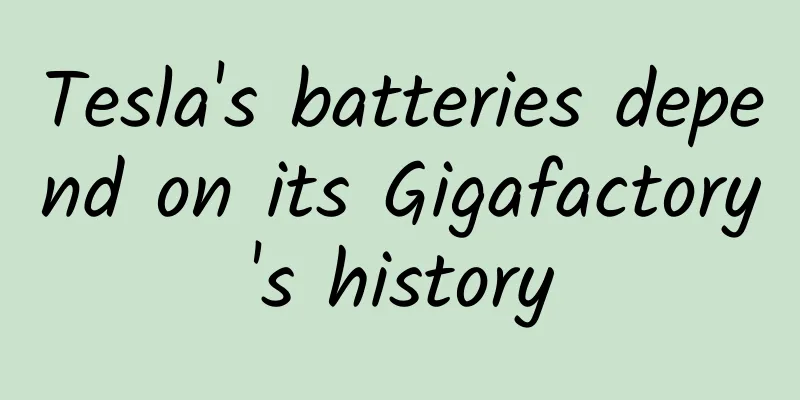Tesla's batteries depend on its Gigafactory's history

|
Tesla has just released its second quarter 2016 financial report, and at an investor conference, CEO Elon Musk once again announced Tesla's grand blueprint to the outside world. That’s right, Tesla is now arguably the world’s hottest and number one electric car manufacturer, and almost all traditional car manufacturers regard Tesla as their primary competitor, whether it’s BMW, Mercedes-Benz, Nissan, or Chevrolet. Many companies’ future plans or existing new products are directly aimed at Tesla. Even sports car brands like Porsche are unwilling to "let go" of Tesla. As an electric car, the battery is undoubtedly one of the most important components. In order to continuously innovate the process and reduce the logistics costs in the lithium battery manufacturing process, thereby reducing the comprehensive manufacturing cost of lithium batteries, Tesla has been planning the mysterious Gigafactory super factory since a long time ago. The origin of the name of Gigafactory is very interesting. It consists of two parts, giga and factory. The factory at the end is very easy to understand, and literally means factory. Giga comes from Greek, which means gigantic. It is a unit of measurement that represents 1 billion, and generates/consumes 1 billion watts of electricity in 1 hour. Therefore, the combination of the two can be directly translated into "super factory". Planning Phase In March 2014, Tesla first announced its lithium battery super factory plan. When the plan was first announced, many media and peers were skeptical. However, as Tesla gradually completed the construction of charging stations around the world, announced new models such as Model X and Model 3, and laid the first charging network running through the east and west of the United States, it seemed that the super factory plan had become an inevitable practice. Tesla plans to invest a total of $5 billion in the construction of the Gigafactory. In addition to Tesla, Panasonic, one of the world's major suppliers of lithium batteries, has also become a major investor in Tesla's Gigafactory. It is reported that in the cooperation between Tesla and Panasonic, Tesla will select, provide and manage land, buildings and utilities. Panasonic will manufacture and provide cylindrical lithium-ion battery cells and invest in related equipment, machinery and other manufacturing tools according to the common wishes of both parties. The two parties have planned a network of supplier partners to produce the required precursor materials. In January this year, Panasonic announced that it would invest $1.6 billion in Tesla, which is obviously a big gamble for Panasonic, whose lithium battery business has been in trouble recently. In recent years, although Panasonic has actively cultivated the automotive battery market, it faces multiple layers of competitive pressure from its rivals in the United States and South Korea. Therefore, this cooperation with Tesla to build the Gigafactory super factory is indeed a big move. Groundbreaking The Gigafactory officially started construction on June 24, 2014. The factory is located in the small town of Reno, Nevada, USA, near Lake Tahoe. It covers a total area of 12.95 square kilometers and the factory area exceeds 539,000 square meters. It is known as the largest single building in the world, equivalent to 107 American football fields. It is also the second largest building in the world in terms of construction area, second only to the Boeing factory in Everett, Washington. On the 29th of last month, Tesla held a grand opening ceremony for the Gigafactory, and changed its previous practice of strictly restricting the media, and began to open it to shareholders and some media. Although the Gigafactory is still under construction, some parts of the plant have already started production. However, at present, the construction progress of the entire factory has only completed 14% of the total progress. Elon Musk said that 31% of the construction progress will be completed by the second quarter of next year, and it is planned to be completed by 2020. The Gigafactory looks like a giant diamond, which is not only beautiful but also saves construction costs and has a higher degree of integration with the surrounding environment. Big for Tesla For Tesla, this super battery factory is of great significance. The first and most obvious benefit is that it can increase the output of lithium batteries and reduce production costs. The battery cost of an electric car accounts for more than one-third of the vehicle cost. Due to the high cost of batteries, the price of electric cars is difficult to popularize. As global automakers begin to produce more hybrid and electric vehicles, the global demand for lithium batteries will increase significantly. Not only electric vehicles, but also many electronic products including smartphones and laptops need to use lithium batteries as a power supply. According to Tesla's estimates, if it produces lithium battery products completely by itself, the comprehensive battery cost will be saved by 30%, which is definitely a considerable expense for Tesla. At the same time, Tesla plans to increase its electric vehicle production capacity to 500,000 by 2020, and the current expectations for the Gigafactory have been increased from 35GWh to 150GWh, almost three times higher than the original plan, and also brought the production capacity of the super factory forward by two years. Therefore, by then, not only the global electric vehicle batteries, but also all other battery-related energy industries including drones will become the customer targets of the super battery factory. In addition, the Gigafactory also takes into account the changes that may occur in battery technology and structure in the next few decades, so the factory's product line design is very flexible and can be adjusted at any time to follow technological changes. In the future, the Gigafactory will manufacture both battery cells and battery modules, thereby reducing costs and ensuring a stable supply and cooperating with the expansion of Tesla's business. Fully implement the concept of environmental protection One of the main advantages of electric vehicles is environmental protection, so Tesla will also thoroughly implement this concept in the battery production environment. It is reported that the Gigafactory is designed to be a zero-energy factory. It does not consume any fossil fuels, and there is no natural gas pipeline network or diesel generator to provide it with electricity. Multiple sources of electricity ensure the factory's emergency power needs, including from renewable energy and energy storage products. First of all, the roof of the entire factory is covered with solar panels, and the electricity that is not consumed during the day will be stored in Tesla's energy storage equipment for use on cloudy days or when there is no light. In addition to using solar energy, the treatment of water resources is also very scientific and efficient. In order to use water more efficiently, the Tesla Super Factory will have its own water circulation and treatment facilities, including a heat recovery system and a wastewater treatment plant. In addition, the Gigafactory also utilizes geothermal and wind power, and all batteries can be recycled. Because Tesla battery packs do not contain any toxic substances and heavy metals, they will be returned to the Tesla Gigafactory at the end of their life cycle, where all components can be disassembled and reused to produce new battery packs. Bright future prospects and huge potential In fact, Tesla's goal of building a super factory is not only to meet the market demand for electric vehicle batteries in the future, but also Tesla's Powerwall and Powerpack energy storage products will be produced in the Gigafactory. At the same time, Tesla not only plans to build this Gigafactory, but will continue to build new factories around the world in the future. It can be seen that Tesla is indeed full of information about the future battery business. It is worth mentioning that the Gigafactory, which is currently in partial production, already has 350 non-construction personnel working in it, and by 2020, the employee size will increase from the planned 6,500 to 10,000, which will undoubtedly greatly promote local employment in Nevada. In 2020, Tesla's electric vehicle production capacity will reach 500,000 units, and by then all of these cars will use lithium batteries from the Gigafactory. Not only electric cars, but also many electronic products we use in the future, such as drones and smartphones, may also be made by Tesla. As a winner of Toutiao's Qingyun Plan and Baijiahao's Bai+ Plan, the 2019 Baidu Digital Author of the Year, the Baijiahao's Most Popular Author in the Technology Field, the 2019 Sogou Technology and Culture Author, and the 2021 Baijiahao Quarterly Influential Creator, he has won many awards, including the 2013 Sohu Best Industry Media Person, the 2015 China New Media Entrepreneurship Competition Beijing Third Place, the 2015 Guangmang Experience Award, the 2015 China New Media Entrepreneurship Competition Finals Third Place, and the 2018 Baidu Dynamic Annual Powerful Celebrity. |
<<: A deep dive into the technical details of Tesla Model 3's super glass
>>: Hackers vs. smart cars: Count the models that failed
Recommend
Zhang Gang, Operation Director of Longzhu Live: Please get the operation logic that operators must know!
The Internet is a sea of pictures and texts, an...
People can stand on the leaves, and the flowers can change three colors! This "magical" plant is actually not mysterious...
Expert of this article: Rong Hai, plant science w...
How to write efficient Android code
As Android-related devices are embedded devices, ...
Conventional and unconventional methods for product operation and promotion
When we do competitor analysis, we look at the co...
These high-value, high-priced "IQ fruits" are out to deceive people again. What are they? Don't buy them anymore!
During the May Day holiday, when you happily go t...
Beware! "Meihua" strengthens to strong typhoon level, with maximum wind force 14! Bringing heavy rain!
Pay attention!!! Typhoon Meihua strengthens to se...
How did LeTV Cast break the deadlock in mobile-TV interoperability behind the surge in tens of millions of users?
“One does not know how expensive firewood and ric...
Kaikeba Code Practice Elite Program 001
Introduction to resources for the 001th issue of ...
Apple is said to be durable, but how durable is the iPhone? Big data gives you the answer
Mobile phones have become an indispensable item i...
The warmest winter in Sichuan is here!
This is the most unfamiliar scenery in Sichuan, a...
Latest Age Regulations for Construction Workers 2022: What is the age limit for migrant workers on construction sites?
In rural areas, many farmers are forced to work i...
New tricks for space processing: turning spacecraft debris into treasure
Recently, a Falcon 9 rocket from the United State...
How to make AI more "human"? MIT research: This is crucial
Written by: Green Apple Editor: HS Layout: Li Xue...
Is it necessary for Guangzhou flower shops to develop mini programs? Why do we need to create a flower mini program?
For flower shop owners, offline channels can no l...









